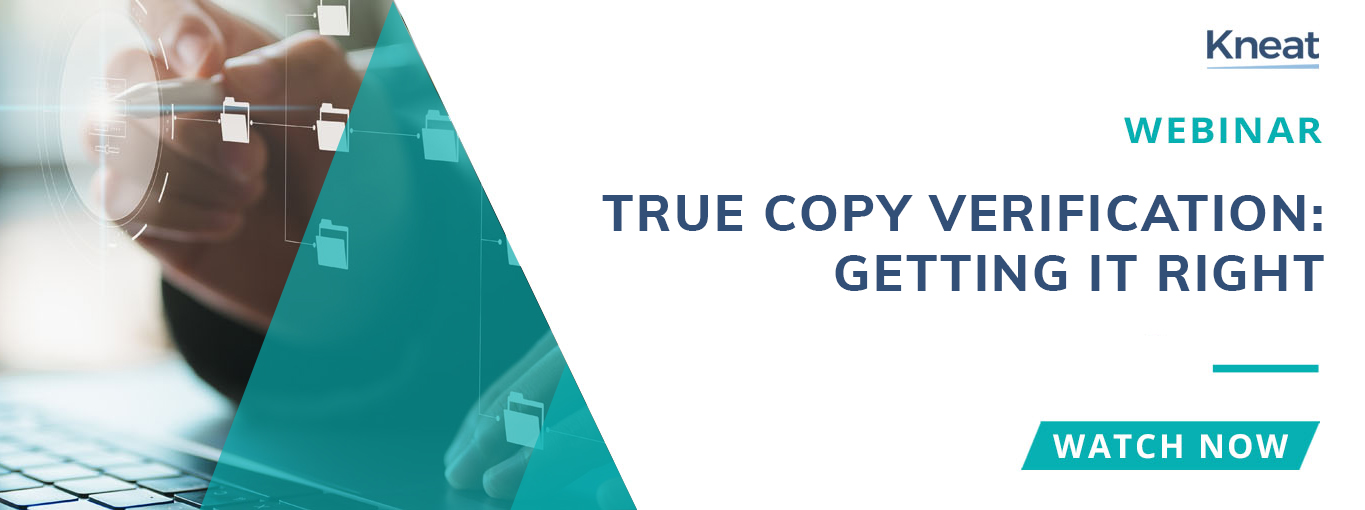The Art of True Copy Verification: Ensuring Authenticity in a Digital World

In today’s increasingly digital landscape, the need for verifying the authenticity of documents has become paramount. When you’re dealing with crucial validation records, ensuring that a copy is a true representation of the original is a fundamental requirement. This process, known as “True Copy Verification,” is essential to maintain trust, security, and compliance in various sectors, including the Life Sciences industry.
Learn more in our on-demand webinar, “True Copy Verification: Getting it Right.”
In this article, we’ll delve into what True Copy Verification is, how second-person verification plays a crucial role in the process, compliant destruction of original copies post-verification, the distinction between static and dynamic data, and the requirements for handling dynamic data.
What Is True Copy Verification?
The current International Society for Pharmaceutical Engineering (ISPE) guidance states: “A True Copy is an exact copy of original documentation that preserves the same content, meaning, and attributes of the original. It is an electronic copy maintained in an electronic document management system.”
True Copy Verification is the process of confirming that a copy of a document is a faithful and accurate reproduction of the original. This verification is crucial when dealing with validation, quality assurance, and compliance documents, as inaccuracies or tampering can lead to serious consequences. The objective is to ensure that the copy maintains the same content, format, and integrity as the original document.
The verification process involves scrutinizing the copy for any alterations, ensuring that it bears the same information, and confirming its authenticity through various methods, including second-person verification.
Correctly Applying Second-Person Verification in the True Copy Process
Second-person verification is an invaluable step in True Copy Verification, although it may not always be required for some non-critical activities, for example C&Q (see examples in our on-demand webinar). It involves a second party, typically an authorized individual or entity, cross-referencing the copy with the original document to confirm its accuracy and authenticity. This ensures an extra layer of security and minimizes the risk of fraud or errors.
Here’s how second-person verification typically works:
1) Authorized Personnel: An individual or organization, such as a validation, quality assurance, or compliance professional, or a designated authority, is responsible for performing the verification.
2) Examination of the Original: The authorized party thoroughly examines the original document to understand its content, layout, and security features.
3) Comparison: The authorized party compares the original with the copy to ensure that every detail matches precisely and is a true and accurate representation of the original. This includes text, images, signatures, watermarks, and any security elements, such as metadata.
4) Documentation: The verification process is documented, often including the date, the names of the parties involved, and any relevant reference numbers.
This second-person verification process is not only a safeguard against forgery but also a way to instill trust in the copy’s authenticity.
How to Compliantly Destroy Original Copies After Verification of True Copy
Once the True Copy Verification process is complete and the copy is deemed authentic, the question arises: what should be done with the original document? Depending on the legal and regulatory framework in place, several options exist for compliantly disposing of the original:
✓ Secure Storage: In some cases, the original paper-based documents may need to be securely stored for a specified period.
✓ Shredding or Destruction: For paper-based documents that are no longer required or when retention periods have expired, compliant shredding or destruction processes must be followed. This often involves the use of specialized document shredders or destruction services that ensure the information cannot be reconstructed.
 The Difference Between Static and Dynamic Data
The Difference Between Static and Dynamic Data
In the realm of True Copy Verification, it’s essential to understand the distinction between static and dynamic data. These terms refer to how data behaves and changes over time.
Static Data
Static data refers to information that remains constant and unchanging over time. It’s a record format such as paper or an electronic record that is fixed and allows little or no interaction between user and record content, such as attachments to validation documents. In the context of True Copy Verification, static data is easier to verify since it should remain consistent between the original and the copy.
Dynamic Data
Dynamic data, on the other hand, is information that can change over time, such as electronic records that allow for an interactive relationship between the user and the record content. Examples include metadata, data from historians, and data from trends. Verifying dynamic data is more challenging because it requires real-time access to the source system to ensure accuracy. In some cases, a timestamp indicating when the data was last updated may also be necessary to verify its authenticity.
Dynamic Data Requirements
When dealing with dynamic data in True Copy Verification, specific requirements must be met to ensure the copy accurately reflects the current state of the original:
✓ Real-Time Access: To verify dynamic data, access to the source system is essential. This allows for instant validation and ensures that the information is up to date.
✓ Timestamps: When dealing with dynamic data, it’s crucial to include timestamps indicating when the data was last updated. This provides transparency and allows the authorized party to verify that the information is current.
✓ Secure Connections: To maintain the integrity of dynamic data during verification, secure connections and protocols should be used to prevent tampering or unauthorized access.
✓ Audit Trails: Maintaining detailed audit trails of dynamic data verification processes is essential for transparency and compliance. These records should include who performed the verification, when it was done, and the results.

Learn More About True Copy Verification
Watch our on-demand webinar “True Copy Verification: Getting it Right” to learn how to eliminate your paper records, whilst maintaining compliance.
You’ll learn:
- What is True Copy Verification
- The correct application of second person verification in the true copy process
- How to compliantly destroy original copies after verification of true copy
- The difference between Static and Dynamic Data
- Dynamic data requirements
About the Author

Lisa Wright, BA, GDL – Content Writer, Kneat
Lisa is an experienced writer whose work is focused on contextualizing the challenges and opportunities for validation, quality assurance, and compliance professionals operating in highly regulated industries. Outside of the office, she’s committed to education and has completed Kneat Academy End User and Power User 1 digital validation software training.
Contact
Talk to us
Find out how Kneat can make your validation easier, faster, and smarter.
Start your paperless validation revolution by speaking to our experts.
